|
ACADIA NATURE NOTES
| Volume 5 |
Spring Number, 1939 |
Number 1 |
FLOWERS PINK
LADY'S SLIPPER or MOCCASIN FLOWER
May - June
Cypripedium acaule - Orchid family.
One of the loveliest harbingers of spring in the shaded woodlands.
| Root |
Fleshy, fibrous. |
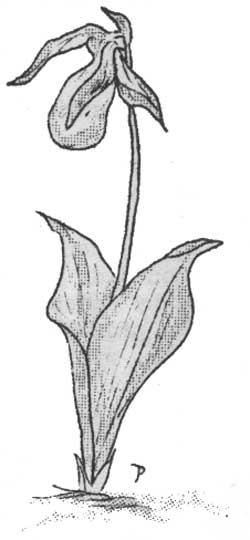 |
| Stem |
Very short, inconspicuous. |
| Flowering Stalk |
6" to 12" high, one-flowered. |
| Leaves |
Two, basal, 6" to 8" long, 2" to 3" wide, thick, occasionally a smaller leaf on flower
stalk. |
| Flower |
Three sepals, three petals, stamens united into a column.
Pink, blossom somewhat peanut-shaped. |
The name "moccasin flower" is an excellent tribute to the American
Indian who loved the same woodland haunts. The scientific name is
literally Venus' Slipper.
The Orchid family is the most peculiar in the vegetable world in the
structure of its flowers. It has three outer sepals and three inner
petals of which one is peculiar in shape. This one is considered a petal
although in the Lady's Slipper it is in the form of a pouch. Technically
it is called the lip of the flower. This large lip is open with a narrow
slit in the front, the edges of which are turned inward. This forms a
trap easy to get into but hard to get out of. A bee enters this open
door and once satisfied with nectar she looks for a way out. She finds a
way but not the way she came in. At the top of the flower on either side
of the column (a single organ formed by the stamens and petals united),
she finds the passage out, just big enough to push through. In pushing
out she brushes against the sticky pollen mass of the stamens and
carries away some of it on her hairy sides. When she enters another
flower, she deposits some of this pollen on the stigma of that flower,
thus accomplishing cross-fertilization. Observers tell us that this
contrivance is so elaborate that it often defeats its own end and the
plants are propagated chiefly by the root.
FLOWERS PINK
BOG LAUREL
Late May - Early June
Kalmia polifolia - Heath family.
Generally in bogs or on shores of cold ponds.
| Stem |
A spreading, scraggly shrub, 6"-20" high, with smooth ascending
branches; branches distinctly 2-edged. |
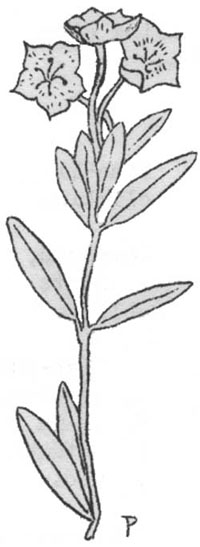 |
| Leaves |
Small, narrowly elliptical, opposite;
dark green above, whitish below, the edge rolled back, 1"-2-1/2"
long. |
| Flowers |
Pink to magenta, in terminal
clusters, about 1/2"-5/8" across. |
| Fruit |
Pod, smooth, oval. |
Found from Labrador to Alaska, also in Greenland.
Honey made from the Kalmia has been found to be poisonous. The
foliage also is very destructive to cattle and sheep because it contains
a dangerous substance which, when eaten, is more dangerous than
strychnine. The Indians were familiar with the poisonous nature of the
leaves and from them made a drink with which they committed suicide. The
leaves are also brewed illegally to make a drink like cheap liquor.
FLOWERS PINK
BEACH PEA
Late May - August
Lathyrus maritimus - Pea family.
Trailing over the loose gravelly sea beaches of the Island is the
Beach Pea.
| Stem |
Vine-like, trailing or climbing definitely angled. |
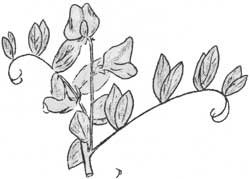 |
| Leaves |
Compound, divided into 6-10 leaflets,
thick, rounded-oblong, 1" to 4" long. |
| Flowers |
Pinkish-purple, large, 1/2" to
1-1/4" long. Somewhat like Vetch in form. Five sepals, ten stamens. Pod,
two-valved. |
| Fruit |
A two-valved pod, like garden pea. |
Named after a similar plant of the bean family by the Greek botanist
Theophrastus.
Often called Vetchling because of its resemblance to the field
vetch.
The blossom also looks like cultivated sweet peas.
FLOWERS PINK
FRINGED POLYGALA or GAY-WINGS
June
Polygala paucifolia - Milkwort family.
Perennial. A delicate plant with very handsome rose-colored flowers, found in open
woods, fields, and meadows of light sandy soils.
| Rootstock |
Slender, twisted. |
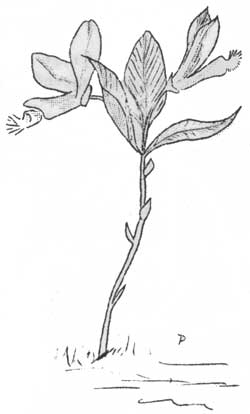 |
| Stems |
3"-6" high; upper part leafy, lower part bearing small oval, leafy
scales; these stems rise from prostrate or subterranean shoots which
bear concealed fertile flowers. |
| Leaves |
Four to five upon a stem, petioled, alternate, ovate,
entire, 1" long, 1/2" - 7/8" wide. |
| Flowers |
Showy, rose-purple, irregular, one to three upon
each stem. Three petals, the middle one keel-shaped and fringe-crested,
the two side ones oblong, concave, and united to the keel the greater
part of their length. Six stamens united into a tube. Ovary
two-celled; style long and somewhat curved. |
| Fruit |
A small, flat, two-seeded pod; the seeds are appendaged with two or
three awl-shaped lobes. |
Pollinated by bees and bee-like flies. Nectar-bearing.
An old name composed of polus, much, and gala, milk, from
a fancied property that increases this secretion.
The Polygala blossom is beautiful in form and color, but very puzzling
in structure. This is due to the fact that the five sepals are neither
symmetrical in shape nor alike in color. Three are greenish and of sepal
like character, two drop their sepal look, become larger than the others
and rose colored -- in short, group themselves with the petals.
FLOWERS PINK
RHODORA
Late May - early June.
Rhododendron canadense - Heath family.
"Rhodora! If the sages ask thee why
This charm is wasted on Earth and Sky
Tell them, dear, that if eyes were made for seeing
Then Beauty is its own excuse for being."
—Ralph Waldo Emerson
| Stem |
A shrub, 1'-4' high, branches slender, ascending or erect. |
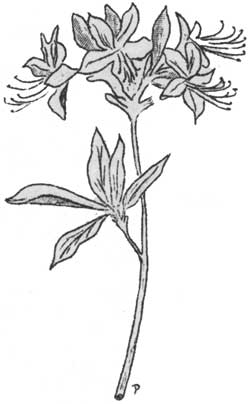 |
| Fruit |
Oval, obtuse and pointed at the apex, narrowed at base, entire dark
green and smooth, or nearly so, above, light green or pale and dull and
slightly hairy, 1" to 2" long. |
| Flowers |
Expanding with or before leaves, lower lip divided into
two oblong obtuse segments. |
| Fruit |
Capsule oblong. |
One of Acadia's finest flower shows comes the last week in May or early
June when Great Meadow is one expanse of color. It is there that Rhodora
comes into all her glory and with characteristic New England pride shows
her gorgeous colors. She is typically New England and found in no other
National Park.
FLOWERS PINK
TWISTED STALK
Late May - June
Streptopus roseus - Lily family.
Found in cold moist woods.
| Root |
Short, creeping, thick. |
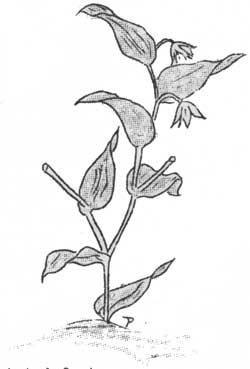 |
| Stem |
Stout, short with bristly hairs, branching above. |
| Leaves |
Green on both sides, 2"-4-1/2" long, finely hairy, clasping
the stem. |
| Flower |
Rose-purple, 1/4" to 3/8" long, six petals, six stamens,
ovary three-celled. |
| Fruit |
Round cherry - red berry. |
Scientific name from the Greek for twisted foot.
This plant is often confused with Solomon's Seal and False Spikenard.
The main points of difference are:
Solomon's Seal - Flowers drooping from leaf axils, in a regular
row.
False Spikenard - Flower a plume of small blossoms at the tip of the
stem.
Twisted Stalk - Flowers, usually solitary, nodding from leaf axils
not in a regular row.
|

